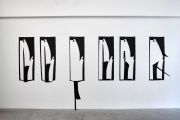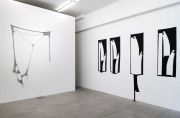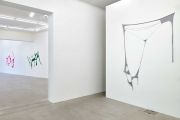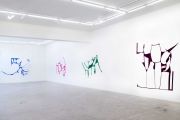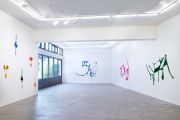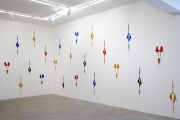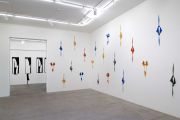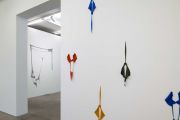Marion Baruch
Letting go endless blooming
25.6.-29.8.2020
Galerie Urs Meile Lucerne
Press Release – English
The artist Marion Baruch possesses a special talent: she always lives in the moment and nurtures herself with the present. What sounds like the simplest, most banal thing in the world is, however, an art in itself, which is reflected in more than just the ninety-year-old artist’s philosophy of life. Her oeuvre is also permeated by this unique energy. Her long-term body of work speaks with a vital voice that has never shied away from consistently pursuing its own path. Living in the now is not child’s play: it requires great
strength.
Then again, this attitude is also connected to the ability to let go—especially with the sense of ease and weightlessness that is particularly manifested in the latest phase of Baruch’s work. It is as if she is constantly renewing the process of creating this multi-layered body of work, as if it were always being “fetched home into its today,”1 as it says in the poem “Homecoming” by Paul Celan (1920–1970). She andthe Romanian poet also share a common heritage and a love for words.
Marion Baruch was born in 1929 to Hungarian-speaking parents in the Romanian town of Timişoara. As a young woman she began studying art at the Academy of Fine Arts in Bucharest, before she emigrated to Israel. She continued her studies at the Bezalel Academy of Arts and Design in
Jerusalem. Thanks to a grant, she was able to go to Rome and study at the Accademia di Belle Arti. She spent time in Paris before finally returning to Italy, where she has lived to this day, with a few sojourns elsewhere. Her nomadic life is reflected in her multilingualism. Besides Italian, Baruch also speaks fluent Romanian, Hungarian, German, French, Hebrew, and English. Even though she regards Hungarian as her native language, she feels at home in many languages. And for this artist, identity is also pluralistic.
This is also true of her art. It seems that, faced with the current situation, Baruch also derives strength from “nowness” and plurality. The artist’s first show at the Galerie Urs Meile explicitly refers to the present time. She responds to the dangers of the pandemic and the limitations imposed to combat it with open-mindedness and positivity. The gallery has purposefully selected newer works that contrast the notion of lockdown and limits with the theme of open spaces, in both the metaphorical as well as the physical sense. The concept of empty space as the basis for artistic and intellectual processes is a central aspect of the artist’s work. Since 2013 Baruch has been working with textile remnants from the fashion industry, giving them new life through her work. To do this, she must do nothing on the one hand, and
yet create an entirely new world on the other. Through her setup, art is created out of nothingness.
The linguistic form of her works plays an important role in their meaning. Vivid proof of this can be seen in the title of the show, Letting go endless blooming. Here, as in haiku, similar motifs of universal scope are condensed into a compact, linguistic form. “Letting go” has several layers of meaning for Baruch. First of all, when it comes to her work with fabric, gravity is a “co-creator” of sorts. As the primary material for her art, fabric is not something that has been assembled or artificially created; it takes on its form through a kind of relaxation. Second, the artist herself must also “let go” of the notion of the absolute creative spirit. It allows and is allowed—perhaps in the sense of the Gelâzenheit of the mystic Meister Eckhart. Lasciar cadere (Italian for “to let drop”) is also one of the works shown that fits
under this rubric, as does the title Traiettorie (“flight paths”). Here, Baruch identifies a movement that creates without doing. Rather, the act of creation is a subconscious process, which, as the title of the show emphasizes, is comparable to the blossoming of a flower. Yet, it is precisely this natural process that embodies pure energy and lust for life!
The plant confronts the abstraction of creativity and technology with the immediacy of metamorphosis, the unity of subject and object, of material and imagination, writes the Italian philosopher Emanuele Coccia in his book The Life of Plants.2 That is a statement that applies very well to Marion Baruch’s way of working, thinking, and living. For this exhibition, the reference to vegetation is particularly apt, if only due to the colors themselves. One piece is called fiori (“flowers”): across an L-shaped wall stretches a field of flowers, an explosion of small, colorful blossoms whose shape is somewhat reminiscent of ovaries. When one recalls that flowers are nothing more than sex organs, then this association is not entirely inappropriate.
The fact that she is hardly able to work in these difficult times is painful to the artist, but still, she manages to find a way to live in the moment, to allow for emptiness and at the same time, to fill it. The selection of works on display once again shows her ability to break down the limitations of her work, to depart from the given framework. Everywhere, the emptiness of the perforated bits of fabric fringes the space, making them part of it. The works of fabric art are like a transparent membrane engaged in an active exchange with their surroundings: they create a space for dialogue. It is typical of Marion Baruch that she always addresses the viewer with her art. Her art is not hermetic, but always open to dialogue with fellow humans. Through this, the artist teaches us without being didactic—a lesson that we ought to
take to heart these days, in particular.
Text by Susanna Koeberle, freelance journalist
English translation by Allison Moseley
The solo show Marion Baruch. Retrospektive - innenausseninnen at the Kunstmuseum Luzern runs until 11 October 2020. On Wednesday, 24 June, 6–8pm, the book vernissage of the exhibition catalogue will take
place at the Kunstmuseum Luzern.
__________________
1 Paul Celan (1959), “Homecoming,” https://www.poemhunter.com/poem/homecoming-30/
2 Translated from: Emanuele Coccia, Die Wurzeln der Welt [2016], Elsbeth Ranke, transl., 6th ed., Munich: Hanser Verlag 2018. Available in English as The Life of Plants, Medford: Polity Press 2017.
press release - deutsch
Die Künstlerin Marion Baruch besitzt eine besondere Gabe: Sie lebt stets im Moment und nährt sich aus der Gegenwart. Was wie die einfachste und banalste Sache der Welt klingt, ist allerdings eine Kunst für sich, die sich nicht nur in der Lebensphilosophie der 90-jährigen Künstlerin widerspiegelt. Auch ihr künstlerisches Werk ist von dieser eigentümlichen Energie durchdrungen. Aus ihrem langjährigen Schaffen spricht eine vitale Stimme, die sich nie gescheut hat, konsequent eigene Wege zu gehen. Im Jetzt zu leben ist kein Kinderspiel: Es bedarf einer grossen Stärke.
Umgekehrt hat diese Haltung mit einer Fähigkeit zum Loslassen zu tun. Mit einer Leichtigkeit und Schwerelosigkeit, die sich gerade in der neusten Schaffensphase von Marion Baruch besonders ausgeprägt manifestiert. Es ist, als würde sich der Prozess der Entstehung dieses vielschichtigen Werks fortlaufend erneuern, als würde es stets «heimgeholt in sein Heute»1, wie es im Gedicht «Heimkehr» von Paul Celan (1920 – 1970) heisst. Mit dem rumänischen Dichter verbindet sie auch ihre Herkunft – und ihre Liebe zum Wort.
Marion Baruch wird 1929 als Tochter Ungarisch sprechender Eltern im rumänischen Timişoara geboren. Als junge Frau beginnt sie an der Akademie der Bildenden Künste in Bukarest Kunst zu studieren, bevor sie nach Israel auswandert. Sie setzt ihr Studium an der Bezalel Academy of Arts and Design in Jerusalem fort. Dank eines Stipendiums kommt sie nach Rom und studiert dort an der Accademia di Belle Arti. Über Paris führt ihr Weg zurück nach Italien, wo sie mit Zwischenstationen bis heute lebt. Ihr nomadisches Leben widerspiegelt sich in ihrer Mehrsprachigkeit. Neben Italienisch spricht Baruch auch fliessend Rumänisch, Ungarisch, Deutsch, Französisch, Hebräisch und Englisch. Obwohl sie Ungarisch als ihre Muttersprache bezeichnet, fühlt sie sich in allen Sprachen zuhause. Identität findet für die Künstlerin im Plural statt.
Das trifft auch auf ihre Kunst zu. Jetzigkeit und Pluralität: Daraus scheint Baruch auch angesichts der aktuellen Situation Kraft zu schöpfen. Die erste Ausstellung der Künstlerin in der Galerie Urs Meile nimmt explizit auf die Gegenwart Bezug. Der Bedrohung der Pandemie und der damit verbundenen Einschränkungen begegnet die Künstlerin mit Offenheit und Positivität. Bewusst wählte die Galerie neuere Werke aus, die dem Eingesperrtsein und der Grenze das Thema Freiräume entgegensetzt – im übertragenen wie auch im physischen Sinne. Der leere Raum als Basis für
künstlerische und intellektuelle Prozesse ist ein zentraler Aspekt im Schaffen der Künstlerin. Seit 2013 arbeitet Baruch mit Textilabfällen aus der Modeindustrie und gibt diesen durch ihre Arbeit ein neues Leben. Dafür muss sie einerseits nichts tun und doch eine vollkommen neue Welt erschaffen. Aus der Leere entsteht kraft ihrer Setzung ein Kunstwerk.
Für die Bedeutung ihrer Arbeiten spielt ihre sprachliche Gestalt eine wichtige Rolle. Das führt auch der Titel der Ausstellung Letting go endless blooming auf anschauliche Weise vor. Hier verdichten sich einem Haiku ähnlich Motive von universeller Tragweite zu einer kompakten sprachlichen Form. Dabei hat Loslassen für Baruch mehrere Bedeutungsebenen. Zum einen ist die Schwerkraft bei ihren Stoffarbeiten gewissermassen eine Koautorin. Der Stoff als Materia prima ihrer Arbeiten ist nicht etwas
Zusammengesetztes oder künstlich Erschaffenes, er gewinnt seine Form durch eine Art Erschlaffung. Zum anderen muss die Künstlerin dafür auch selber loslassen, von der Idee des absoluten Schöpfergeists ablassen. Sie lässt zu und wird dabei gelassen, im Sinne vielleicht der «Gelâzenheit» des Mystikers Meister Eckhart. «lasciar cadere» (fallen lassen) heisst sinnigerweise auch eine der gezeigten Arbeiten. Auch der Titel «Traiettorie» (Flugbahnen) passt dazu. Baruch benennt damit eine Bewegung, die erschafft, ohne zu handeln. Der Akt des Erschaffens ist vielmehr ein unbewusster Vorgang, der – wie im Titel der Schau angetönt – mit dem Erblühen einer Blume vergleichbar ist. Doch genau dieser natürliche
Vorgang verkörpert pure Energie und Lebenslust!
Der Abstraktion des Schöpfens und der Technik stelle die Pflanze die Unmittelbarkeit der Metamorphose gegenüber, die Einheit von Subjekt und Objekt, von Materie und Vorstellung, schreibt der italienische Philosoph Emanuele Coccia in seinem Buch «Die Wurzeln der Welt»2. Das ist eine Aussage, die man sehr gut auch auf Marion Baruchs Art zu arbeiten, zu denken und zu leben übertragen könnte. Für diese Ausstellung ist der Verweis auf das Pflanzliche schon nur durch die Farbigkeit der gezeigten Werke besonders zutreffend. Eine Arbeit trägt den Titel «fiori»: über eine L-förmige Wand erstreckt sich ein Blumenfeld, eine Explosion kleiner bunter Blüten, die von ihrer Form her auch etwas an Eierstöcke
erinnern. Wenn man bedenkt, dass Blumen nichts anderes als Geschlechtsorgane sind, dann ist diese Assoziation nicht ganz unpassend.
Dass sie in dieser schweren Zeit kaum arbeiten kann, ist für die Künstlerin zwar schmerzhaft, dennoch findet sie einen Weg, den Moment zu leben, die Leere zuzulassen und zugleich zu füllen. Auch in der Auswahl der ausgestellten Werke zeigt sich einmal mehr ihre Fähigkeit, mit ihrer Arbeit Grenzen aufzubrechen, den vorgegebenen Rahmen zu verlassen. Überall franst die Leere der ausgestanzten Stoffstücke in den Raum, wodurch diese Teil davon werden. Die Stoffarbeiten gleichen einer durchlässigen Membran, die in einen aktiven Austausch mit ihrer Umgebung tritt: Sie schaffen einen
Begegnungsraum. Es ist typisch für Marion Baruch, dass sie sich mit ihrer Kunst stets auch an die Betrachtenden richtet. Ihre Kunst ist nicht hermetisch, sondern stets offen für den Dialog mit den Mitmenschen. Die Künstlerin lehrt uns damit, ohne belehrend zu sein, eine Lektion, die wir gerade zurzeit besonders beherzigen sollten.
Text von Susanna Koeberle, freischaffende Journalistin
Die Einzelausstellung Marion Baruch. Retrospektive - innenausseninnen im Kunstmuseum Luzern dauert noch bis zum 11. Oktober 2020.
Am Mittwoch, 24. Oktober findet im Kunstmuseum Luzern von 18 - 20 Uhr
die Buchvernissage des Kataloges zur Ausstellung statt.
________________________
1 Paul Celan (1959), Sprachgitter, in: Paul Celan, Gedichte in zwei Bänden, erster Band, S. 156
2 Emanuele Coccia (2016): Die Wurzeln der Welt, 6. Auflage, München
Downloads
Press Release (English, PDF)
Press Release (Deutsch, PDF)
Events
Opening:
Thursday, June 25, 2020
5.30 - 7.30pm

